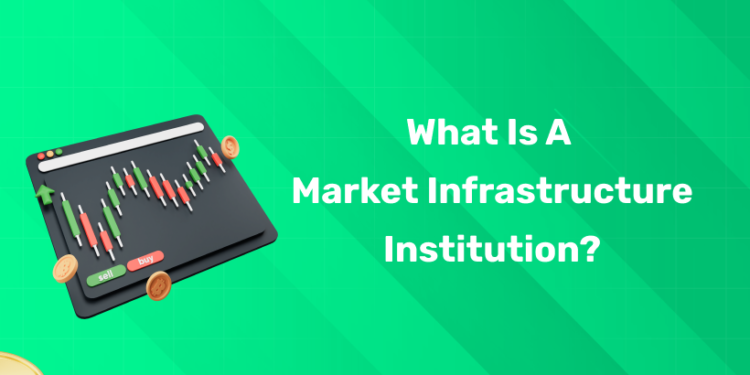Table of Contents
Introduction
As an outsider, do you feel that the financial market is a system that functions very smoothly?. However, the truth is that behind every trade, transaction, and settlement, there is an intricate web of systems that make it all possible. For most investors, this invisible backbone remains out of sight, yet it determines how smoothly money moves across the global economy.
In the absence of this system, trading would be full of chaos, risky, and inefficient. If we go through the world’s major economic crises that have happened in the past, it shows what happens when these foundations falter. That’s where Market Infrastructure Institutions come into the picture, the invisible shields that make sure that every transaction in the financial market happens efficiently and securely.
Now you might be curious to know what Market Infrastructure Institutions are, how they work, why they matter, and what the future holds for them in an increasingly digital economy. In this blog, we’ll delve deep into all this and much more.
Learn Stock Marketing with a Share Trading Expert! Explore Here!
What is a Market Infrastructure Institution?
1: What is a stock?
A Market Infrastructure Institution (MII) is the central pillar of a strong and well-regulated financial market. Stock exchanges, clearing corporations, and depositories are some of the entities that are part of an MII. The highlight of these institutions is that they enable seamless trading, clearing, and settlement of securities, thus ensuring transparency, protection of investors, and financial stability.
In India, MIIs are regulated by the Securities and Exchange Board of India (SEBI). It functions to maintain transparency, protect investors, and bring in financial stability i.e. the integrity of the financial ecosystem.
Now let’s check how it happens in the real world. For example, when an investor buys shares on a stock exchange, several Market Infrastructure Institutions come into the picture. Here the exchange executes the trade, the clearing corporation guarantees settlement, and the depository records the new ownership.
Why Market Infrastructure Institutions Are Important
Without Market Infrastructure Institutions, the financial system would struggle with trust and efficiency. These entities ensure that financial transactions are executed in an efficient and secure manner. To add on, MIIs play an integral role in:
- Maintaining investor confidence
- Bringing down systemic risk and
- Facilitating smooth capital market operations
3 main components of Market Infrastructure Institutions
Market Infrastructure Institutions typically consist of three main components:
1. Stock Exchanges
Securities such as stocks, bonds, and derivatives are traded on centralized platforms. These platforms are known by the name stock exchanges. The importance of stock exchanges is that they ensure transparent price discovery and facilitate an organized marketplace for buyers and sellers.
2. Clearing Corporations
The intermediaries between buyers and sellers are called clearing corporations. They ensure that both sides fulfill their obligations, and the clearing corporation’s main role is to handle the settlement process. i.e., the process in which money and securities are exchanged and guarantee completion even in cases of default.
3. Depositories
It is the depositories that hold securities in electronic form and facilitate the transfer between investors. They also get rid of the risks and inefficiencies associated with physical certificates. This is done by providing secure, dematerialized ownership records.
In short, it is these 3 institutions together that help maintain order, reliability, and transparency in the financial ecosystem.
How Market Infrastructure Institutions Work
To understand how Market Infrastructure Institutions function, let’s break down a typical trade:
- Order Placement: An investor places an order to buy or sell through a broker on a stock exchange.
- Execution of trade: The exchange, after matching the order with a counterparty, executes the trade.
- Clearing: Following that, the clearing corporation calculates the obligations of both parties and makes sure that they have the necessary funds or securities.
- Settlement: On the settlement date, funds and securities are exchanged, typically through the depository.
- Record Maintenance: The depository updates ownership records, ensuring accurate tracking of each one’s ownership.
This sequence shows how different Market Infrastructure Institutions collaborate to make trading efficient and trustworthy.
Stock Market Training Reviewed & Monitored by SEBI Registered RA
Trusted, concepts to help you grow with confidence. Enroll now and learn to start investing the right way.
Know moreKey stock exchanges and depositories in India
The 5 major stock exchanges in India are:
1. National Stock Exchange (NSE)
When it comes to trading volume, NSE is India’s largest stock exchange.
2. Bombay Stock Exchange (BSE)
BSE has specialised in commodities trading, i.e. dealing in gold, metals and crude oil.
3. Multi-Commodity Exchange (MCX)
MCX has specialised in commodities trading, i.e. gold, crude oil and metals.
4. National Commodity & Derivatives Exchange (NCDEX)
An important exchange that facilitates agricultural commodity trading. This includes wheat, barley, chana bajra, soybean etc.
5. Metropolitan Stock Exchange of India (MSEI)
Focusing on equity, debt, and currency markets, MSEI is a relatively newer exchange.
Challenges Faced by Market Infrastructure Institutions
By now you would have got a clear picture of the foundational role played by Market Infrastructure Institutions. Having said that, in the modern world they face several challenges as well:
1. Cybersecurity Risks
As you know, there’s a big jump in financial transactions going online. Due to this reason, cyber threats have become a major cause of concern. Thus, nowadays it has become the top priority to protect sensitive trading and settlement data from breaches.
2. Technological Disruption
The increasing popularity of blockchain, decentralized finance (DeFi), and digital currencies have led to both challenges and opportunities. Unless and until traditional Market Infrastructure Institutions adapt, they face the risk of becoming obsolete.
3. Regulatory Compliance
To ensure market integrity, Market Infrastructure Institutions operate under strict regulations. However, the negative aspect is that evolving global compliance standards can lead to a rise in operational costs and complexity.
4. Operational Risks
System failures, technical glitches, or human errors can disrupt the settlement process thus badly affecting market confidence.
5. Global Interconnectivity
When compared to that of the past, today’s financial markets are more interconnected. For example, if a disruption happens in one country’s MII, it can have ripple effects across the globe. Thus, it is quite important to focus on robust cross-border coordination.
Recent Developments
1. SEBI mandates 2 executive directors on boards of MIIs
In September 2025, the Securities and Exchange Board of India (SEBI), the stock market regulator in India issued governance norms for Market Infrastructure Institutions. As per the communication, it is mandatory to appoint 2 executive directors (EDs) on the governing boards of MIIs. According to the new guidelines from SEBI, Market Infrastructure Institutions are required to prioritise critical operations, regulatory compliance, risk management, and investor grievance redressal over commercial interests. The purpose behind SEBI’s new move is to strengthen accountability and operational oversight within MIIs.
2. SEBI tightens internal audit norms for MIIs
In May 2025, SEBI tightened the internal audit norms for market infrastructure institutions. According to the market watchdog’s announcement, the managing directors have been barred from being part of audit committees. However, key managerial personnel (KMPs) are permitted to be invited to attend with the approval of the committee’s chairman without any voting rights.
Learn Stock Marketing with a Share Trading Expert! Explore Here!
Future of Market Infrastructure Institutions
Technology and innovation is reshaping the future of Market Infrastructure Institutions. The 5 top trends driving their evolution are:
1. Blockchain and Distributed Ledger Technology (DLT)
From the perspective of MIIs, Blockchain offers the scope for faster, transparent, and more secure transactions. Many MIIs are experimenting with DLT to streamline clearing and settlement.
2. Tokenization of Assets
Digital tokens representing real-world assets can bring a drastic change to how securities are traded and settled. MIIs are in the process of adapting to manage and regulate tokenized assets in an effective way
3. Artificial Intelligence and Automation
AI is being used to predict market anomalies, detect fraud, and improve decision-making. The other areas where automated systems are improving efficiency are trade processing and compliance checks.
4. Cross-Border Integration
In line with the globalization of financial markets, MIIs are working toward interoperability, thus helping investors to trade seamlessly across markets and jurisdictions.
5. Sustainability and ESG Integration
Sustainability is pretty important and cannot be overlooked. As part of this, MIIs are adopting greener technologies and supporting ESG-focused investment initiatives to align with global sustainability goals.
In short, the next phase of Market Infrastructure Institutions will merge advanced technology with robust governance and resilient frameworks.
Key Takeaways
- Market Infrastructure Institutions, known as MIIs are the central pillar of global financial markets and they ensure trust, stability, and efficiency.
- Stock exchanges, clearing corporations, and depositories are some of the MIIs, each entity having distinct, but interconnected roles.
- MIIs bring down risk, improve liquidity, and contribute to market confidence.
- Though there are challenges like cybersecurity threats and regulatory changes, innovation in blockchain, AI, and automation is redefining how these institutions work.
- The continued evolution of Market Infrastructure Institutions will shape the stability and inclusiveness of global markets in the future.
Stock Market Training Reviewed & Monitored by SEBI Registered RA
Trusted, concepts to help you grow with confidence. Enroll now and learn to start investing the right way.
Know moreFrequently Asked Questions
What are Market Infrastructure Institutions?
The term Market Infrastructure Institutions stands for entities such as stock exchanges, clearing corporations, and depositories. They enable the trading, clearing, settlement, and record-keeping of financial transactions ensuring safe and efficient operations of markets.
What are the major types of Market Infrastructure Institutions?
Stock exchanges, clearing corporations, and depositories are the 3 main types of MIIs. Of these, each handles a specific part in the trade lifecycle.
What is the importance of Market Infrastructure Institutions?
MIIs make sure that financial transactions are executed efficiently and securely. They play an important role in maintaining investor confidence, lowering systemic risk and enabling smooth operations of capital markets.
How do Market Infrastructure Institutions boost investor confidence?
Market Infrastructure Institutions make sure that every transaction is transparent, verified, and settled securely and this results in investors trusting the market system.
What are the challenges faced by Market Infrastructure Institutions?
The biggest challenges faced by MIIs are cybersecurity threats, regulatory changes, operational failures, and technological disruption.
How is technology transforming Market Infrastructure Institutions?
Blockchain, AI, and automation are offering benefits such as making trading faster, more transparent, and more secure simultaneously reducing manual intervention.
What is the future outlook for Market Infrastructure Institutions?
In the future, the focus will be on digitization, resilience, and sustainability, thus making sure that MIIs remain relevant in a fast changing financial world.













